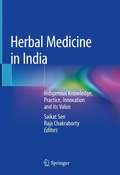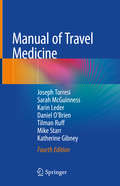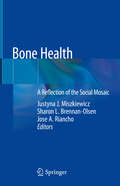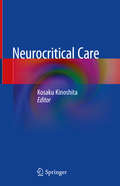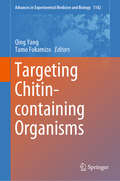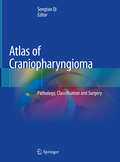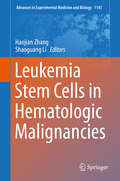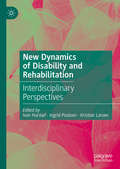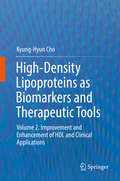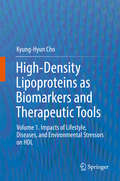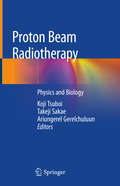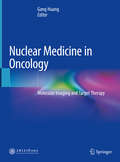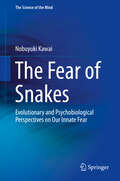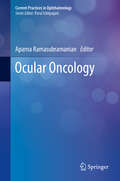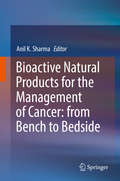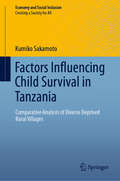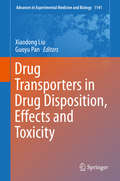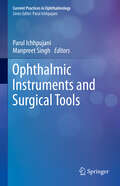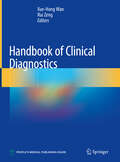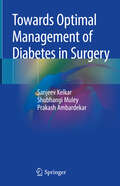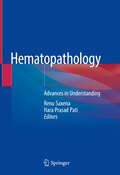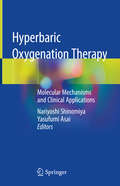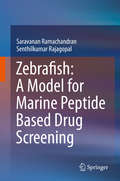- Table View
- List View
Herbal Medicine in India: Indigenous Knowledge, Practice, Innovation and its Value
by Saikat Sen Raja ChakrabortyThis book highlights the medical importance of and increasing global interest in herbal medicines, herbal health products, herbal pharmaceuticals, nutraceuticals, food supplements, herbal cosmetics, etc. It also addresses various issues that are hampering the advancement of Indian herbal medicine around the globe; these include quality concerns and quality control, pharmacovigilance, scientific investigation and validation, IPR and biopiracy, and the challenge that various indigenous systems of medicine are at risk of being lost. The book also explores the role of traditional medicine in providing new functional leads and modern approaches that can offer elegant strategies for facilitating the drug discovery process. The book also provides in-depth information on various traditional medicinal systems in India and discusses their medical importance. India has a very long history of safely using many herbal drugs. Folk medicine is also a key source of medical knowledge and plays a vital role in maintaining health in rural and remote areas. Despite its importance, this form of medicine largely remains under-investigated. Out of all the traditional medicinal systems used worldwide, Indian traditional medicine holds a unique position, as it has continued to deliver healthcare throughout the Asian subcontinent since ancient times. In addition, traditional medicine has been used to derive advanced techniques and investigate many modern drugs. Given the scope of its coverage, the book offers a valuable resource for scientists and researchers exploring traditional and herbal medicine, as well as graduate students in courses on traditional medicine, herbal medicine and pharmacy.
Manual of Travel Medicine: A Pre-travel Guide For Health Care Practitioners
by Joseph Torresi Sarah McGuinness Karin Leder Daniel O’Brien Tilman Ruff Mike Starr Katherine GibneyThe fourth edition of this well received book provides an authoritative and up-to-date resource to support good practice in travel medicine, a field that has evolved substantially in recent years. Concretely, there has been intensified monitoring of health problems among travelers, as well as extensive research efforts, which have led to the development of evidence-based approaches to the field. The book includes expert recommendations regarding e.g. immunizations, malaria prophylaxis, travelers’ diarrhea, altitude sickness, emerging infections, and non-infectious health issues encountered by travelers. It provides a practical approach to the pre-travel consultation and management of most issues that arise in medical care for travelers. In addition, it provides expert advice for high-risk travelers, e.g. those with immunosuppression, the elderly, pregnant women and young children. The text offers a user-friendly, practical handbook for healthcare practitioners during their clinical consultations, as well as nurses and pharmacists.
Bone Health: A Reflection of the Social Mosaic
by Justyna J. Miszkiewicz Sharon L. Brennan-Olsen Jose A. RianchoThis multidisciplinary book addresses three lines of evidence (medieval, contemporary, and epigenetic) regarding the effect of human socio-economic status on bone health. It provides an overview of the extent to which human social background affects adult bone quality and quantity, and makes recommendations for future skeletal biology research into lifestyle-related musculoskeletal disorders. The book is divided into three major parts, the first of which discusses bone and dental health in medieval human skeletal remains from distinct socio-economic status groups. In turn, Part 2 reviews bone health in contemporary human populations with a range of social backgrounds; in addition, a conceptual model proposing a social gradient of osteoporosis and fracture risk related to biological mechanisms and cumulative stressors throughout the human lifecycle is presented. Lastly, Part 3 highlights the role of epigenetics in socially patterned risk factors for skeletal disorders, and discusses how epigenetic mechanisms transduce the psychosocial environment and increase the risk of developing conditions such as osteoporosis. Overall, the book highlights the importance of considering the social-biological nexus in future skeletal biology research and future treatment of bone disease. Increased awareness of this nexus can potentially improve individual and population-level bone health interventions, reducing the social inequities observed in fracture risk. Given its scope, the book offers a valuable resource for researchers, academics, and students in the fields of medicine, epidemiology, the health sciences, biological anthropology, human anatomy and adaptation, developmental studies of human societies, human biology, and any field concerning musculoskeletal disorders and health. It will also benefit clinical practitioners evaluating osteoporosis, osteopenia, fracture risk, bone quality and quantity.
Neurocritical Care
by Kosaku KinoshitaThis book discusses the factors that affect outcomes in patients requiring various types of neurocritical care. Neurocritical care was originally developed to manage patients with traumatic brain injury or stroke. Today, neurocritical care involves patients with a wide variety conditions, including not only brain injury, cerebrovascular disease and brain tumors but also post cardiac arrest syndrome, metabolic disorders, sepsis-related encephalopathy, degenerative diseases, and electrolyte abnormalities. Recently, there has been a focus on improving the outcomes and patients’ quality of life. Covering the latest topics in the field, and written by specialists such as neurosurgeons, anesthesiologists and neurologists, the book provides an update on therapeutic / management strategies for disorders requiring neurocritical care for emergency physicians, intensivists and critical care physicians.
Targeting Chitin-containing Organisms (Advances in Experimental Medicine and Biology #1142)
by Qing Yang Tamo FukamizoThis book provides a comprehensive overview of chitin biology and chitin metabolism related enzymes. Chitin, the second most abundant biopolymer in nature after to cellulose, is a linear biopolymer composed of β-1,4-linked N-acetylglucosamine (GlcNAc), and an essential component in the exoskeletons of insects, mites, ticks and crustaceans, the egg shells of parasitic nematodes, and fungal cell walls. Although some chitin-containing organisms are a threat to human health, food safety and agricultural production, non-chitin containing organisms like humans, mammals and plants have an innate immune response to these hazardous organisms. The book provides researchers and students with information on the recent research advances concerning the biology of chitin-containing organisms as well as cross-talks between chitin-containing and non-chitin-containing organisms. Highlighting chitin remodeling enzymes and inhibitors, it also offers drug developers essential insights into designing specific molecules for the control of hazardous chitin-containing organisms.
Atlas of Craniopharyngioma: Pathology, Classification and Surgery
by Songtao QiThis book aims to facilitate readers to understand the origin, growth pattern and relationship between tumor and adherent structure of craniopharyngioma, so as to improve the cure rate and safety of surgery. It’s contributed by Neurosurgery Department of Nanfang Hospital, Southern Medical University, China, which focuses on the management of craniopharyngioma. This book covers histoembryology of craniopharyngioma, together with anatomical morphology and abundant clinical data, systematically showing an innovative classification method, i.e. QST classification. This classification method can better reflect the different origin and growth pattern of craniopharyngioma,the relationship between tumors and surrounding structure of the tumor growth pattern, and clinical significance in surgery. The 70 clinical cases with different classification and treatment history are discussed as an important reference for surgical treatment of craniopharyngioma. The anatomy, morphology and pathology of sellar region also have great reference value for researchers in the field of neural science. The underlying intention of this book is to help bring a change in the concept that “craniopharyngioma is an incurable benign tumor only due to its anatomical location”.
Leukemia Stem Cells in Hematologic Malignancies (Advances in Experimental Medicine and Biology #1143)
by Haojian Zhang Shaoguang LiThis book introduces readers to the biology of leukemia stem cells (LSCs) and emphasizes the necessity and importance of targeting LSCs in the treatment of hematopoietic malignancies. It addresses the role of leukemia stem cells in different leukemia diseases and molecular signatures, as well as the metabolic and epigenetic regulation of leukemia stem cell function. With regard to solid tumors, a significant number of blood cancers are believed to be derived from leukemia stem cells (LSCs), which are responsible for disease progression, relapse and drug resistance. Consequently, new therapeutic strategies need to be developed by focusing on the complete eradication of LSCs. Given its scope, the book offers a valuable asset for graduate students and scientists in the fields of cell biology and cancer research etc.
New Dynamics of Disability and Rehabilitation: Interdisciplinary Perspectives
by Ivan Harsløf Ingrid Poulsen Kristian LarsenThis collection provides a broad coverage of recent changes in medical and vocational rehabilitation in Northern Europe. It presents analyses that cut across health sciences, medical sociology, disability studies and comparative welfare state research. Through this interdisciplinary perspective, the book explores the changing roles of patients, caregivers, professionals and institutions, and the wider implications of these changes for social inequalities in health. What obstacles do different groups of patients encounter when negotiating the complex chains of medical and vocational services? Who decides regarding references to specialized treatments, and the provision of comprehensive and coordinated services, and different types of benefits and material support? What is the importance of the resources that patients and caregivers bring to bear in the rehabilitation process?
Emergencies in Neurology: Volume II
by Mamta Bhushan Singh Rohit BhatiaThis is the second edition (in two volumes) of a well-received book that reflects current practices in the management of neurological emergencies. It was written bearing in mind the needs of first-contact physicians, who may be neurology trainees, neurology consultants, or interns. Special attention has been paid to various aspects of managing patients at the emergency department, from taking a good clinical history, to completing a quick and focused clinical examination, to investigating and commencing treatment. Neurological emergencies are unique in that they appear abruptly, generally follow a volatile course, and require a prompt yet balanced response. The management of neurological emergencies has been a major challenge in the past, and today, early and aggressive approaches are generally recommended. Exploring these and other aspects, the book offers a valuable asset for all practitioners seeking answers to the questions that inevitably arise while attempting to manage such critical situations.
High-Density Lipoproteins as Biomarkers and Therapeutic Tools: Volume 2. Improvement and Enhancement of HDL and Clinical Applications
by Kyung-Hyun ChoThis book is the second of two volumes that offer a comprehensive, up-to-date account of current knowledge regarding high-density lipoprotein (HDL), the changes that occur in HDL under different conditions, the clinical applications of HDL, and means of enhancing HDL functionality. In this volume, the focus is on the improvement of HDL, enhancement of its functionality, and the use of HDL for therapeutic purposes. In the first section, up-to-date information is provided on such topics as the tumor regression-promoting and antidiabetic activities of reconstituted HDL containing V156K apolipoprotein A-I, the enhancement of HDL effects by high doses of vitamin C, the benefits derived from incorporation of growth hormones 1 and 2 into rHDL, and the biological functions of omega-3 linolenic acid in rHDL. The enhancement of HDL functionality by policosanol and the resultant benefits are thoroughly examined in a separate section. Readers will also find the latest information on clinical applications of HDL. Here, specific topics include the enhancement of adenoviral gene delivery and the delivery of rapamycin. In documenting the latest knowledge in this field, this volume will be of interest to both researchers and clinicians.
High-Density Lipoproteins as Biomarkers and Therapeutic Tools: Volume 1. Impacts of Lifestyle, Diseases, and Environmental Stressors on HDL
by Kyung-Hyun ChoThis book is the first of two volumes that offer a comprehensive, up-to-date account of current knowledge regarding high-density lipoprotein (HDL), the changes that occur in HDL under different conditions, the clinical applications of HDL, and means of enhancing HDL functionality. HDL comprises a diverse group of lipoproteins and its composition and metabolism are dynamic. In this volume, the focus is on the changes observed in HDL under different health statuses, with particular attention to the functional and structural correlations of HDL and apolipoprotein A-1. The impacts of a wide variety of factors on HDL are examined in depth, covering, for example, diet, exercise, smoking, age, diverse diseases, and different forms of environmental pollution. It has long been known that HDL has anti-atherosclerotic and antidiabetic properties, and more recently its anti-aging activities have been recognized. These benefits of HDL are highly dependent on its lipids, proteins, apolipoproteins, and enzymes, and specifically their composition and ratios. In documenting the latest knowledge in this field, this volume will be of interest to both researchers and clinicians.
Actin Polymerization in Apicomplexan: A Structural, Functional and Evolutionary Analysis
by Avinash KaleThis book discusses in detail the structural, evolutionary and functional role of actin and its regulatory proteins in gliding motility in apicomplexan organisms, a unique phenomenon found in actin-myosin cytoskeletal elements. The book also explores the potential of different actin regulators, namely formin, profilin, actin depolymerization factor (ADF), capping proteins (CPα and CPβ), cyclase-associated protein (CAP) and coronin 13–24 as potential drug targets against malaria. As the chief components of the gliding motor, the actin-regulator proteins are characterized by unique features that make them promising targets for structure-based drug design. Lastly, the book proposes a mathematical model, based on kinetic data mining, to help understand the most vital regulators for actin polymerization dynamics.
Proton Beam Radiotherapy: Physics and Biology
by Koji Tsuboi Takeji Sakae Ariungerel GerelchuluunThis book offers a comprehensive, practical guide to understanding the physical and biological characteristics of proton beam radiotherapy. The application of proton beams to the treatment of solid cancers has expanded exponentially over the last decade due to their physical properties, which make it possible to administer higher doses of radiation to lesions with only a minimum dose to the surrounding healthy tissues. Accordingly, understanding the basic aspects of proton beam radiotherapy is a primary concern not only for medical physicists and radiation biologists, but also for all physicians involved in cancer treatment using proton beams. The major aspects discussed include the technique’s development background, the generation and delivery system for proton beams, physical characteristics, biological consequences, dosimetry, and future prospects in both medical physics and radiation biology in terms of effective cancer treatment. Gathering contributions from experts who provide clear and detailed information on the basics of proton beams, the book will greatly benefit not only radiological technicians, medical physicists, and physicians, but also scientists in cancer radiotherapy.
Nuclear Medicine in Oncology: Molecular Imaging and Target Therapy
by Gang HuangThis book introduces molecular imaging and Target Therapy in various cancers. The first part is the subjects and primary focused on the basics of nuclear physics, radiation dosimetry, nuclear medicine equipment and small animal imaging equipment. The second part is about the radiopharmaceutical and commonly used clinical radiopharmaceuticals, including positron emission imaging agent, single photon emission imaging agent, and radionuclide therapy agents as well as their radioactive preparation, quality control, and a brief clinical application were included. Also, this part introduces a number of new imaging agents which were potential value of clinical applications. In the third part, the clinical application of the conventional imaging agent 18F-FDG in different tumors and neurodegenerative diseases and 18F-Dopa imaging in the nervous system are discussed. Besides the clinical applications of 99mTc labeled radiopharmaceuticals in parathyroid disease, coronary heart disease, myocardial infarction, sentinel lymph node, metastatic bone tumors, liver and gallbladder disease in children are introduced. Finally, the applications of radionuclide 131I on treatments of Graves' disease and differentiated thyroid cancer and metastases are investigated respectively. This book is a useful reference for professionals engaged in nuclear medicine and clinical research, including clinical nuclear medicine physicians, nuclear medicine engineers and nuclear medicine pharmacists.
The Fear of Snakes: Evolutionary and Psychobiological Perspectives on Our Innate Fear (The Science of the Mind)
by Nobuyuki KawaiThis book provides a series of compelling evidence that shows that humans have innate fear of snakes. Building on the previous studies on the Snake Detection Theory (SDT), the author presents a summary of psychological and neuropsychological experiments to explain the fear of snakes in humans and primates. Readers will come to understand why and how we are afraid of snakes from an evolutionary perspective.The first half of the book discusses the history of psychological behaviorism and neobehaviorism. The latter half of the book consists mainly of the experimental studies performed by the author with a focus on three key items: First, compared with other animals, snakes especially draw the attention of primates and humans. Second, the ability of primates and humans to recognize snakes with particular efficiency. Third, processing mechanisms within the brain for snake detection is discussed from a new viewpoint.The book offers a unique resource for all primatologists, psychologists, neuroscientists, anthropologists, herpetologists, and biologists who are interested in the evolution of visual and cognitive systems, mechanisms of fear, snakes or primates.
Ocular Oncology (Current Practices in Ophthalmology)
by Aparna RamasubramanianThis book concentrates on ocular oncology covering the latest advances in both adult and pediatric oncology. The topics covered are: retinoblastoma, melanoma, graft vs. host disease, squamous cell neoplasia, intraocular lymphoma, coats disease, and choroidal hemangioma. Each chapter is written by an expert in the field and covers the most recent developments in management. As part of the series “Current Practices in ophthalmology” this volume is meant for residents, fellows-in-training, generalist ophthalmologists and specialists alike.
Bioactive Natural Products for the Management of Cancer: from Bench to Bedside
by Anil K. SharmaThis book illustrates the importance of the Natural Biometabolites, which offer a rich reservoir of candidate compounds for drug discovery in the battle against cancer. Recent research and development efforts concerning anti-cancer drugs derived from natural products have led to the identification of numerous candidate molecules that inhibit cancer cell proliferation and metastasis using a variety of mechanisms. Given its scope, the book offers a valuable resource for cancer biologists and general oncologists alike, while also benefitting research professionals in Science, Nursing, Medicine, Biochemistry, Genetics and Bioscience who wish to understand the fundamentals of prognosis and prediction in tumorigenesis. Moreover, the book provides an essential platform for understanding drug resistance mechanisms and combatting the growing menace of multidrug resistance.
Factors Influencing Child Survival in Tanzania: Comparative Analysis of Diverse Deprived Rural Villages (Economy and Social Inclusion)
by Kumiko SakamotoThis book addresses the essential topic of child survival in Tanzania, especially focusing on the role of mutual assistance, which has received little attention to date. Further, it identifies a range of key factors for child survival by combining a literature review, regional data analysis, and case studies. These studies center on rural villages in high Under-5 mortality rate (U5MR) regions and assess their strengths and weaknesses regarding child survival. By focusing on deprived rural areas as of 2002 and evaluating the improvements in the 2012 census data, the book also highlights the potential held by rural semi -subsistence economies. An analysis of the focus villages indicates that children in food-sharing circles had better chances of survival. However, food sharing is not necessarily inclusive; a significant number of children have fallen out of such circles, especially in mainland villages. Furthermore, monetary support for children’s medicine has often failed to arrive in time. Lastly, the book argues that, in addition to direct factors such as access to health services, water and sanitation, food intake, and education, it is essential that children receive inclusive support at various levels: family, community, village, national, and international.
Drug Transporters in Drug Disposition, Effects and Toxicity (Advances in Experimental Medicine and Biology #1141)
by Xiaodong Liu Guoyu PanThis book provides with a comprehensive overview of the role of drug transporters in drug disposition and efficacy/toxicity, as well as drug-drug interactions and recent advances in the field. Transporters are known determinants of drug disposition and efficacy/toxicity. In general, they are divided into solute carrier (SLC) and ATP binding cassette (ABC) families, and are located along cell membranes, where they mediate drug uptake into cells and export out of cells. Drug transporters are essential in maintaining cell homeostasis, and their gene mutations may cause or contribute to severe human genetic disorders, such as cystic fibrosis, neurological disease, retinal degeneration, anemia, and cholesterol and bile transport defects. Conversely, some diseases may also alter transporter functions and expressions, in turn aggravating disease process. Further, since over-expression of some ABC transporters is a potential contributor to multidrug-resistance (MDR), the book presents a number of strategies to overcome MDR, including ABC transporter inhibitors and applying epigenetic methods to modulate transporter expressions and functions. This book is useful for graduate students and professionals who are looking to refresh or expand their knowledge of this exciting field.
Ophthalmic Instruments and Surgical Tools (Current Practices in Ophthalmology)
by Parul Ichhpujani Manpreet SinghThe goal of this book is to offer readers essential information on the morphological features of ophthalmic surgical instruments, their possible uses, and intraoperative handling of the standard and latest instrumentation across ophthalmology subspecialties. Detailed content on basic and advanced instruments for both anterior and posterior segment surgeries is also provided, helping readers use them in the most effective and efficient manner. This handy manual also provides valuable insights into proper sterilization techniques, suture materials, and common OR equipment and machines. The text is richly illustrated throughout.As part of the series “Current Practices in Ophthalmology”, this volume is intended for residents, fellows-in-training, generalist ophthalmologists, and specialists alike.
Handbook of Clinical Diagnostics
by Xue-Hong Wan Rui ZengThe book covers basic theories, basic knowledge and basic skills on clinical diagnosis, basic requirements for doctors’ ethical conduct, clinical reasoning and documentation of medical records during the process of making a diagnosis. It consists of six parts, including ‘Symptoms’, ‘History Taking’, ‘Physical Examination’, ‘Supplementary Examination’, ‘Common Clinical Diagnosis Techniques’, and ‘Diagnostic Process and Clinical Reasoning’. A vocabulary index is included for easy reference at the end of the book. This book is compiled by authors of 14 Chinese medical schools and universities, whose years of experience in clinical diagnostics, rich overseas learning and working experiences. This book is included in the first round of English textbooks series for clinical medicine major of China's higher medical colleges; and is among "13th Five-Year" planning textbooks of National Health Commission of the People’s Republic of China. It is also an ideal textbook for MBBS (Bachelor of Medicine and Bachelor of Surgery) student It is a co-publication book with People's Medical Publishing House (PMPH). The ISBN of PMPH version in China is 978-7-117-23852-6.
Towards Optimal Management of Diabetes in Surgery
by Sanjeev Kelkar Shubhangi Muley Prakash AmbardekarThis book addresses key principles in the optimal management of diabetes to facilitate smooth and safe anesthesia and surgery with the best possible outcomes. It addresses a range of topics, including: diabetic emergencies, glycemic control in emergencies, the routine perioperative setting, preoperative evaluation in routine and emergency surgery, intra- and post-operative management for neurosurgery, cardiothoracic surgery, gestational diabetes, bariatric surgery and other major surgeries. A dedicated chapter on Metabolic Havoc of Uncontrolled Diabetes provides the in-depth understanding of diabetic pathophysiology required in surgical situations, while a special chapter addresses commonly asked questions on surgery and diabetes. Despite many recent advances in surgery, anesthesia, and diabetes research, perioperative diabetes management is often not addressed adequately. This is largely due to an insufficient understanding of insulin physiology and its pharmacokinetics and pharmacodynamics under normal and stressful conditions. The optimal management of surgery in diabetes calls for an integrated, collaborative, and proactive approach. Surgeons, anesthetists and physicians should know the central, basic aspects of perioperative diabetes management and understand the contribution that each one makes to the best outcome, as well as their limitations.
Hematopathology: Advances in Understanding
by Renu Saxena Hara Prasad PatiThis book covers recent advances in the understanding and management of essential hematological pathologies. In addition to updates on Hodgkin’s lymphoma, acute myeloid leukemia and other disorders, it provides essential information on transplant pathology, and the molecular and genetic aspects of hematological disorders. Offering a practical approach to lymphoma diagnosis, the book will help hematologists and pathologists alike make accurate diagnoses in keeping with the latest classifications and methodologies. A wealth of photographs and algorithms help readers understand the laboratory approach to the diagnosis of hematological disorders, reflecting the latest advances in the field. The book offers a valuable resource for residents of MD pathology, DM hematopathology and clinical hematology, as well as practitioners of hematology.
Hyperbaric Oxygenation Therapy: Molecular Mechanisms and Clinical Applications
by Nariyoshi Shinomiya Yasufumi AsaiThis book focuses on hyperbaric oxygenation (HBO) therapy from the molecular biology perspective and its clinical applications, including molecular mechanisms of HBO’s positive effect on cellular function in hypoxic tissues.HBO is a therapeutic tool that enhances oxygen supply to hypoxic tissues and improves wound healing/tissue remodeling. Currently HBO therapy is applied to a wide range of clinical cases, which include not only acute hypoxic diseases but also many chronic and refractory diseases involving tissue hypoxia or intractable infection. HBO therapy is a well-recognized regimen for many researchers and clinicians. The first half of the book outlines basic molecular mechanisms of HBO and their potential applications for clinical activities, while the second half describes the rationale behind introducing HBO therapy into suitable clinical cases and presents successful clinical reports. It is primarily written for HBO clinicians, physiologists and basic research scientists, but is also of interest to clinicians who have an interest in this field considering introducing HBO therapy.
Zebrafish: A Model for Marine Peptide Based Drug Screening
by Saravanan Ramachandran Senthilkumar RajagopalThis book offers a comprehensive overview of toxicology, highlighting the significance of peptide-based toxins from marine environments. It discusses the principles of protein-carbohydrate and domain-domain interactions to increase our understanding of toxicology in zebrafish models, as well as drug interaction mechanisms and target definition in drug discovery. It also reviews the structure of marine peptides/toxins and the toxicology of peptide secreting cells and cells that respond to these enzymes, and describes the normal and abnormal toxicology of marine peptides in zebrafish models. Offering insights into the field of proteomics, particularly current practice and research models for solving its many riddles, the book also explains the analytical principles of marine protein-protein and protein-carbohydrate interaction in the context of teratogenicity in target identification in peptide- based drug discovery. Lastly, the book methodically examines the preclinical research on marine proteins/peptides.
